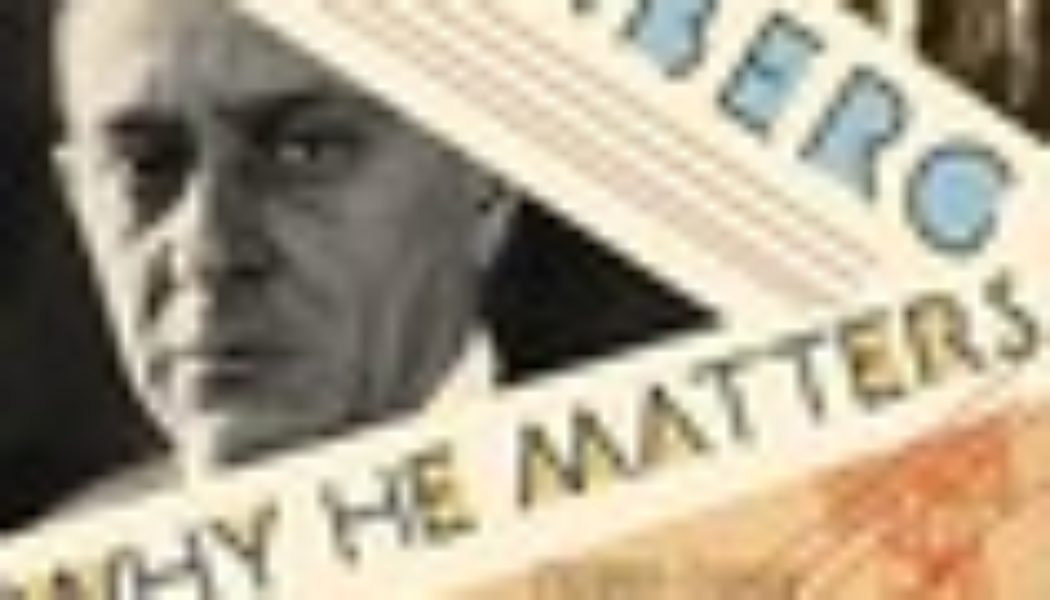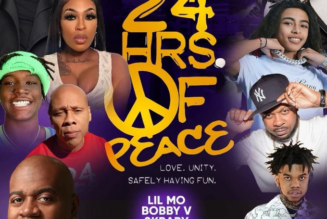On December 1, 1900, at an intimate concert hall in Vienna, a respected local baritone gave the premiere of some early songs for voice and piano by Arnold Schoenberg. Today this music, though written in an elusive harmonic language, comes across as exuding hyper-Wagnerian richness and Brahmsian expressive depth. But the audience in Vienna broke into shouts, laughter, and jeers. From that day on, as Schoenberg ruefully recalled two decades later, “the scandal has never ceased.”
The author Harvey Sachs relates this story, and describes the songs sensitively, in his new book, Schoenberg: Why He Matters. As Sachs makes clear, the “scandal” only got worse. In 1908, Schoenberg premiered the Second String Quartet, his boldest step thus far toward breaking the tethers of tonality—the musical language of major and minor scales and keys that had been around for centuries. Plush with wayward harmonies and arching vocal lines, the music is dark, moody, and entrancing. But most of the audience heard only piercing dissonance and rambling stretches of ugly sounds. One reviewer deemed the piece not a composition but a “pathological case,” a “worthless assault” on the ears of listeners, for which the composer should be “declared a public nuisance.”
Sachs’s book, targeted to music-loving general readers, is less an impassioned defense of an indisputably influential composer than an earnest attempt by an engaging writer and insightful music historian to explain Schoenberg’s significant achievements and understand the lingering resistance to his works. These scores still “fascinate many people in the profession,” Sachs asserts, but “continue to meet with apathy, and often downright antipathy, on the part of most listeners.”
Sachs, the author of the critically acclaimed biography Toscanini: Musician of Conscience, admits to being an unlikely candidate to take on this task. He calls himself “Schoenberg-curious rather than a Schoenberg expert.” But this, he hoped, might make him more trustworthy to countless Schoenberg skeptics among classical-music devotees. If they find Schoenberg’s music baffling, off-putting, and excessively challenging, Sachs understands why and doesn’t really disagree.
But by maintaining that “most listeners” still cling to this perception of Schoenberg and those who followed in his path, Sachs winds up compounding the problem, at least to this admitted Schoenberg lover. The stigma is reinforced. Also, he only glances at a larger related issue that has consistently nagged at me.
The early 20th century was an era of fervent experimentation and radical ventures in all of the arts. Think of what emerged in other fields during the early 1920s when Schoenberg was writing his first 12-tone pieces. For a decade or more, cubist paintings such as Picasso’s 1921 Three Musicians had been literally shattering norms of representation by breaking up and reassembling shards of images into abstract configurations. James Joyce’s Ulysses, published in 1922, was banned in the United Kingdom for content deemed obscene when the real shocker was pages upon pages of seemingly stream-of-consciousness writing. Pirandello’s Six Characters in Search of an Author opened in 1921 and overturned notions of what narrative drama could be. T. S. Eliot’s The Waste Land at once rattled and riveted readers of poetry in 1922.
A century later, one has to reserve a timed ticket to get into a Picasso exhibit at most museums, or a retrospective of Kandinsky. Culturally curious people, young and old, seem to accept that a “challenging” painting—or modern dance work, or play, or independent film—can be exciting, mind-expanding, really cool, and sort of out there precisely because it’s challenging. Why in classical contemporary music do so many people equate challenging with intimidating—or even infuriating?
Classical music was deemed, even by some musicians (though a minority, I’d argue), to have gone wrong in the middle decades of the 20th century. And Schoenberg is still seen as the main culprit.
Sachs genuinely comes across as trying to make a strong case for Schoenberg as a challenging, yes, but consequential composer. He does an admirable and efficient job telling the story of Schoenberg’s life, career, and struggles (the book is just more than 200 pages), and shows how early experiences fortified his later resolve to radically shake up contemporary music.
Born in 1874 in Vienna to a lower-middle-class Jewish family (his father kept a shoe shop), Schoenberg was drawn early to music. At around 16, he had to take a job as a bank clerk after his father died. But he made musical friends and became ever more focused and ambitious. His tenaciousness paid off. A composer who in his youth was compelled to teach himself compositional forms by subscribing to an encyclopedia’s instruction guide, he eventually wrote two books on harmony that are still in use and is considered among the century’s most significant teachers. At 23, in 1898, Schoenberg converted to Lutheranism, and his iconoclasm played out here as well. When Hitler came to power in Germany in 1933, he reconverted to Judaism at the most dangerous moment, becoming an outspoken advocate of Jewish solidarity and defiance. In 1933, he emigrated to America, where he wound up living in Los Angeles, across the street from Shirley Temple, and found a friend, and tennis partner, in George Gershwin.
Those early years in Vienna, when he faced disdain, left him both defensive and determined, and ready to try on the role of visionary prophet in contemporary music. Schoenberg “would see himself as a lonely David using his slingshot to fend off hordes of cultural Philistines who were incapable of grasping, or unwilling to grasp, the beauty and the importance of his ideas and his work,” Sachs writes.
That attitude emboldened Schoenberg as he confronted what he saw as the “crisis” of tonality that came to a head in the early 20th century. The musical system that listeners were comfortable with (think of Maria teaching the von Trapp children do, re, mi) was a kind of harmonic hierarchy in which melodic lines and chords could wander off and become ambiguous as long as the music never lost complete touch with the main key of any piece, or passage, of music. But the music of the late 19th and early 20th centuries had grown so harmonically unmoored that Schoenberg felt, with some justification, that the functionality of major and minor keys had seriously dissipated.
He dared to cut the bonds, to write pieces that embraced this ambiguity and took it further, radically so. For some years, he wrote freely atonal pieces, in which extreme harmonic ambiguity became for him a new norm. Finally, he thought, if composers, he especially, were writing music that didn’t revolve around one key but gave equal weight to all 12 notes, why not systematize this?
He devised a system based on invented “tone rows,” as he called them, a series of all 12 notes put in an order without an established central key; the music would progress without any one note repeated until its turn came up again. This may seem a terribly cerebral conceit. (Sachs wisely doesn’t go into the details.) But two points are crucial. First, the technique actually allowed for all kinds of permutations, because the rows could be gone through forward or backwards, or inverted, or transcribed, and much more. Second, Schoenberg wanted audiences to forget about the methodology and just listen, even if the notes in a piano piece seemed all skittish and jumpy, if the sonorities sounded ungrounded, flinty and dissonant; listeners should give themselves over. Once he devised the technique, he felt liberated. In 1921, still swept up in a flush of nationalism he would later regret, Schoenberg boasted to a friend that he had discovered something that would assure “the dominance of German music for the next century.”
That’s where he was wrong. He had not discovered the next stage of music, because, it can be argued, there’s been no next stage. Music can change, even dramatically, without progressing to some higher, complex realm. And tonality was not in such a crisis after all, as Stravinsky, Bartok, Prokofiev, Britten, Shostakovich, Copland, and a whole roster of composers would prove as the 20th century unfolded.
Rather, 12-tone music was an exhilarating leap into the beyond, an invitation to let go, to dispense, at least for a while, for the duration of a piece, with what Leonard Bernstein in his Norton Lectures at Harvard maintained was an inherent need in human beings from all cultures for music that loosely adheres to some kind of tonal harmonic mooring.
My strongest objection to Sachs’s account of what happened comes up for the first time in the book’s prologue, when he writes that Schoenberg’s 12-tone compositional technique and its offshoots, which were “virtually obligatory among composers struggling for recognition in the third quarter of the twentieth century,” have been “either abandoned or drastically altered, often beyond recognition” by most younger composers. He adds that atonality and the 12-tone technique “have proved to be dead ends for most listeners and for many—perhaps even most—professional performing musicians as well.”
This seems unfair and too sweeping. Did cubism prove a dead end because few painters today emulate Picasso’s specific approach and technique? For a couple of decades, abstract expressionism seemed to dominate and drive contemporary painting. Some influential critics maintained that this approach defined modern art. Similar claims were made by influential, if regrettably dogmatic, 12-tone composers in the 1960s and ’70s who held teaching posts at universities. They dominated the intellectual high ground over their timid colleagues who, as they saw it, still hewed to various kinds of tonality.
All such pronouncements were wrong. Abstract expressionism remains an exhilarating development that still influences painters whose works look little like those of Willem de Kooning or Jackson Pollock. And the impact of the bold experiments pioneered by Schoenberg is ever present.
Go to a contemporary music concert at any conservatory or university. It’s safe to say that none of the young composers on the programs are writing anything close to strict 12-tone works. Still, in almost every piece, you hear intrepid elements of atonality, pointillist riffs, the tart harmonic twang and flighty figurations characteristic of Schoenberg & Co., even when the overall musical language may be drawing from many styles—tonality in the manner of Copland or Britten, minimalism, folk music, jazz, electronica, whatever. And film scores for decades have been thick with stretches of gnarly, 12-tonish sounds to convey mystery, angst, and intensity. Looked at this way, Schoenberg’s atonal and 12-tone works, far from being dead ends, were door openers.
Even in his own time, as Sachs shows, Schoenberg was not as dismissed as is generally assumed. He did have powerful champions and his share of gratifying successes. In a compelling chapter, Sachs discusses the ecstatically received 1912 Berlin premiere of Pierrot Lunaire, a piece that boldly blends modernist atonal music with Berlin cabaret. Written for an actress and a small instrumental ensemble, the piece sets 21 poems by Albert Giraud (translated into German) relating the exploits of the timeless Pierrot character, who appears in a moon-drunk state, singing of lust, violence, nightmares, and heresy. The voice part, tailored to the actress’s talent, is written in a kind of song-speech that Schoenberg called “Sprechstimme.” The music “‘fulfills’ the words and adds dimensions to them,” Sachs writes, “to such a degree that one feels as if the words have grown out of the music itself, in a sort of onomatopoeic symbiosis, which of course is not the case.”
Sachs explains the dearth of prominent orchestras’ performances of major Schoenberg works by pointing to the inherent complexities and awkward technical difficulties of the scores. Sachs writes admiringly of the brilliant violinist Hilary Hahn’s recording of Schoenberg’s Violin Concerto, but points out, quoting Hahn, that she needed a couple of years to train her hands to play it and to uncover the music’s “grace, wit, lyricism, romanticism and drama.”
But I could imagine many superb violinists devoting two years to mastering the concertos by Tchaikovsky or Brahms, among the most difficult in the canon. In 1970, on Beethoven’s 200th birthday, I heard Rudolf Serkin play a monumental performance of Beethoven’s daunting Hammerklavier sonata at Carnegie Hall. Some weeks later, I was able to congratulate him in person for that unforgettable Hammerklavier. He looked at me and said, “It took me 50 years.”
Also, assessing the significance of a composer’s works by the current popularity of his pieces is not quite right. The stigmatization of Schoenberg has stuck, unfortunately. Yet I find that with just a little help, open-minded listeners respond. In classes I’ve taught, I’ve won over the Schoenberg-averse by playing a Bach musette and then the musette from Schoenberg’s Suite for Piano, Op. 25, which is almost like a 12-tone transformation of a Bach suite. Except for the way the pitches were picked, the Bach and the Schoenberg are strikingly similar, the same short-short-long dance rhythm, the same skipping, impish character.
The argument that classical music has never recovered from the wrong turn taken in the middle decades of the 20th century seems dated and downright wrong. Judging by the reactions of audiences I’ve been part of over the past 20 years, even just in New York, the climate for contemporary music has gotten more and more welcoming. It seemed an apt reading of the cultural moment when in 2020 the New York Philharmonic largely eschewed commemorating the 250th birthday of Beethoven and instead inaugurated Project 19, a series of works commissioned from 19 women composers to commemorate the centennial of the Nineteenth Amendment. The Metropolitan Opera has given New York premieres in recent seasons of unapologetically challenging—yes, that word—but arresting operas, including Kaija Saariaho’s L’Amour de Loin and Thomas Adès’s The Exterminating Angel. This season, in an inventively contemporary and vibrantly choreographed production, the Met is presenting its house premiere of Anthony Davis’s X: The Life and Times of Malcolm X, a long-overdue hearing of a breakthrough work from this Pulitzer Prize–winning composer. Davis has written that he attempted to blend “the improvised and subversive spirit of the blues” with the form and structure of “the post-tonal harmonic language of Berg and Stravinsky.”
Despite what you may hear, many works by Schoenberg and his circle, especially his devoted student Alban Berg, written during those tumultuous decades of change, have been embraced by audiences. In the fall of 2021, when an ailing Michael Tilson Thomas heroically conducted a program with the New York Philharmonic ending with Beethoven’s Eroica symphony, the high point, for me and for many, was a magnificent performance of Berg’s 1935 Violin Concerto, with Gil Shaham as a soloist. This wrenching, sublime piece folds passages of tonal music, including strands of a plaintive Bach chorale, into the complex musical language that Schoenberg pioneered.
The performance received a long, ardent ovation from an audience of attentive listeners who didn’t seem to know that they were supposed to find 12-tone music alienating.
When you buy a book using a link on this page, we receive a commission. Thank you for supporting The Atlantic.










